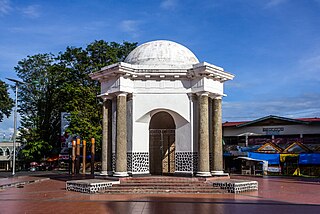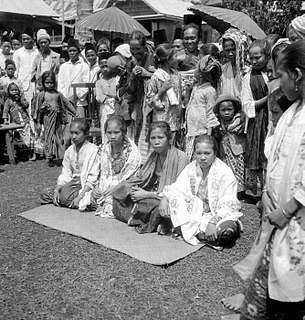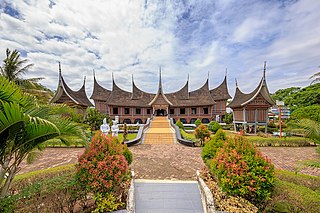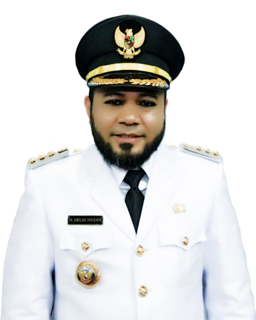Provinces of Indonesia are the 34 largest subdivisions of the Indonesia and the highest tier of the local government. Provinces are further divided into regencies and cities, which are in turn subdivided into districts (kecamatan).

Minangkabau is an Austronesian language spoken by the Minangkabau of West Sumatra, the western part of Riau, South Aceh Regency, the northern part of Bengkulu and Jambi, also in several cities throughout Indonesia by migrated Minangkabau. The language is also a lingua franca along the western coastal region of the province of North Sumatra, and is even used in parts of Aceh, where the language is called Aneuk Jamee.

Batik is an Indonesian technique of wax-resist dyeing applied to the whole cloth. This technique originated from the island of Java, Indonesia. Batik is made either by drawing dots and lines of the resist with a spouted tool called a canting, or by printing the resist with a copper stamp called a cap. The applied wax resists dyes and therefore allows the artisan to colour selectively by soaking the cloth in one colour, removing the wax with boiling water, and repeating if multiple colours are desired.

Bengkulu is a province of Indonesia. It is located on the southwest coast of Sumatra. It was formed on 18 November 1968 by separating out the former Bengkulu Residency area from the province of South Sumatra under Law No. 9 of 1967 and was finalized by Government Regulation No. 20 of 1968. Spread over 19,813 km2, it is bordered by the provinces of West Sumatra to the north, Jambi to the northeast, Lampung to the southeast, and South Sumatra to the east, and by the Indian Ocean to the northwest, south, southwest, and west.

Fort Marlborough is a former East India Company fort located in Bengkulu City, Sumatra. It was built between 1713-1719 by the East India Company under the leadership of Governor Joseph Collett as a defensive fort for the British East India Company's Residency there. It was one of the strongest British forts in the eastern region, second only to Fort St. George in Madras, India.
In Indonesia, village or subdistrict is the fourth-level subdivision below a district, regency/city, and province. There are a number of names and types for villages in Indonesia, with desa being the most frequently used for regencies and kelurahan for cities. According to the 2019 report by the Ministry of Home Affairs, there are 8,488 urban villages and 74,953 rural villages in Indonesia.
Jambi is a Malayic language spoken in Jambi province, Indonesia. It is closely related to Palembang Malay in neighbouring South Sumatra and Bengkulu Malay in Bengkulu Province.

Lubuklinggau, is a city in South Sumatra, Indonesia. It has an area of 419.80 km² and had a population of 201,308 at the 2010 Census the latest official estimate was 216,064. The city was formerly part of the Musi Rawas Regency from which it was separated in 2001.

Kepahiang is a regency in Bengkulu Province of Indonesia. It is located on the island of Sumatra. It covers an area of 710.11 km2, of which a high percentage (27%) is still forest. It had a population of 124,865 at the 2010 Census and 149,737 at the 2020 Census. The regency seat is Kepahiang town. The local population consists of various ethnic groups such as Rejang, Serawai, Javanese, Lembak and Sundanese, among which Rejang forms the majority in Kepahiang.

Srivijaya archaeological park, formerly known as Karanganyar archaeological site, is the ancient remnants of a garden and habitation area near the northern bank of Musi river within Palembang vicinity, South Sumatra, Indonesia. Remnants of ancient man-made canals, moats, ponds and artificial islands discovered in this area suggests the site was related with a 9th-century settlement related to the Srivijaya empire. Several artifacts, such as Buddhist statues, beads, pottery and Chinese ceramics were found in this area, confirming the area was once a dense human habitation.

Indang also called Dindin badindin is a traditional Minangkabau Islamic dance originating from West Sumatra, Indonesia. Indang dance grows and develops in the Minangkabau community as a portrayal of the arrival of Islam in West Sumatra in the 13th century.

The Thomas Parr Monument is a monument located in Bengkulu, Bengkulu, Indonesia and dedicated to Thomas Parr, the British Resident of Bengkulu who was killed in 1807. Constructed the year after his death, it is considered a cultural property of Indonesia.

The North Sumatra Museum or locally known as Northern Sumatra Museum, is a state-owned museum located along H.M Jhoni Street, Medan, Indonesia. This museum is the largest museum in North Sumatra and includes a variety of cultural heritage of Indonesia, as well as art and crafts from various ethnic groups in North Sumatra.

Rejang people are an Austronesian ethnolinguistic group, native to the some parts of Bengkulu Province and South Sumatera Province in the southwestern part of Sumatera Island, Indonesia. They occupied some area in a cool mountain slopes of the Barisan mountain range in both sides of Bengkulu and South Sumatra. With approximately more than 1,3 million people, they form the largest ethnic group in Bengkulu Province. Rejang people predominantly live as a majority in 5 out 10 regencies and city of Bengkulu Province, while the rest of them who lives in South Sumatera resides at 7 villages in the district called as Bermani Ulu Rawas. The Rejangs are predominantly an Islam adherent group with small numbers following a religion other than Islam. According to research, Rejang people are the descendants of the Bukar-Sadong people who migrated from Northern Borneo (Sarawak).

Adityawarman Museum is a State Museum located in Padang, Western Sumatra. As a State Museum, Adityawarman Museum is officially known as the State Museum of West Sumatra. The museum displays ethnographic collections of items related to the culture of the Province of West Sumatra, particularly the culture of Minangkabau and Mentawai.

Mpu Tantular Museum is a State Museum located in Buduran, Sidorajo, East Java, a province of Indonesia. Formerly the Stedelijk Historisch Museum Soerabaia, the museum began as a society established by Godfried Hariowald von Faber in 1933. Today, the museum was the State Museum of the Province of East Java "Mpu Tantular".
The 2019 Liga 3 was the third season of the Liga 3 under its current name, the fourth season under its current league structure, and the only amateur league football competition in Indonesia.

Helmi Hasan is an Indonesian politician from the National Mandate Party who is the mayor of the city of Bengkulu.
The 2019 Liga 3 Regional Round was played from 18 November to 5 December 2019. A total of 81 teams competed in the regional round to decide 26 of the 32 places in the national round of the 2019 Liga 3.














